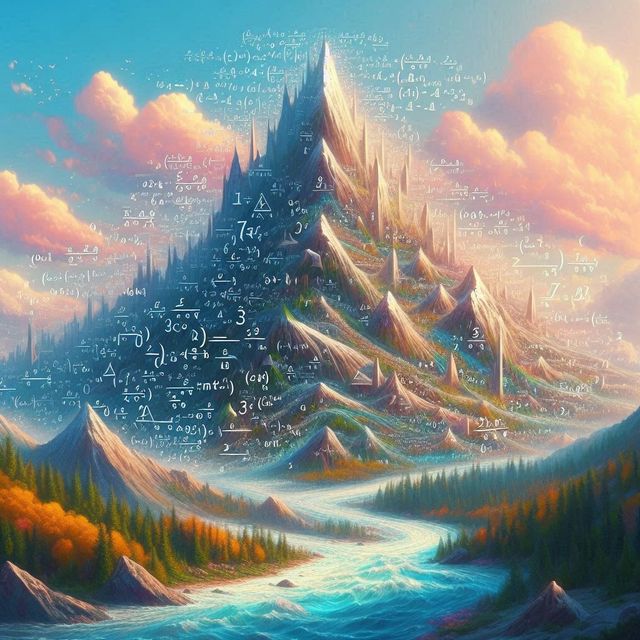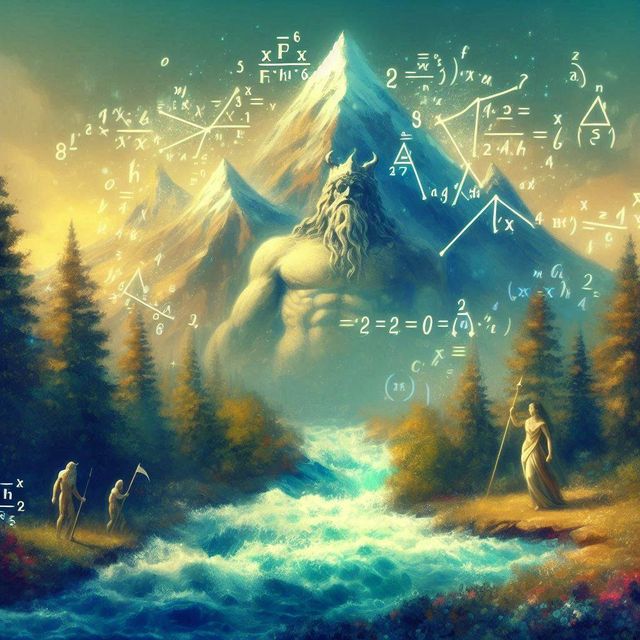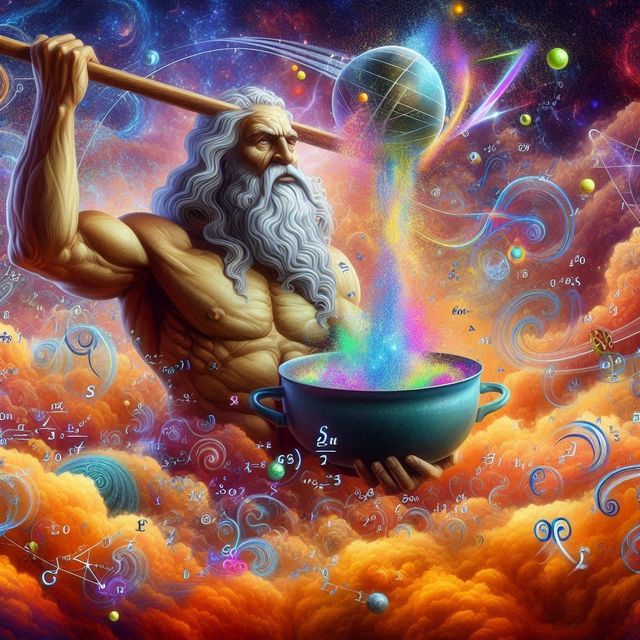-
Mythili Vutukuru
- Published on
In the poem “Discordium Mathematica”, the poet Vijay Fafat embarks on an ambitious quest to describe the metaphysical origins and evolution of mathematics using evocative poetry. The poem is set in a fictional universe of jealous Gods and enterprising humans, where mathematics is the ultimate divine principle. The plot runs as follows, across ten chapters. Mathamos, the immortal God of mathematics, desires a “magnificent monument for his craft”. So, with his great efforts is born “All-Mathematiks”, an “infinite fluttering scroll of verities”, that contains within itself “all things provable and false”. However, over time, some shadows and creaks manifest in its “deductive chains”. Mathamos, after much thought, stems the decay by building a soaring Mount Analogue, from which flows the thousand-headed river Logos, whose “rational currents” water the fertile lands of mathematics and keep renewing it. Now, another goddess Euclidia (a mathematical Prometheus, if you may), wishes to bring down the waters of Logos to her “disordered domain”, so that she may build a cosmos out of Chaos, one in which sentient beings could rise and partake of the “wondrous sciences”. Her wish is denied by an angry and jealous Mathamos, forcing Euclidia to resort to theft to divert a part of Logos to her lands, in the form of a river-tributary called “Aleph”. However, Mathamos uses some clever deceit to thwart her attempts, and curses Euclidia’s realms to be governed by a broken and incomplete mathematics. This is brought about by another Lord God inadvertently disrupting Euclidia’s thieving dream, while engaged in his effort to prove the Completeness and Consistency of All-Mathematiks.
The story then traces the arc of the evolution of modern mathematics and sciences in Euclidia’s lands, from Euclid’s “The Elements”, “Principia Mathematica” of Whitehead and Russell, the axiomatic systems of Zermelo-Fraenkel, to the discovery that the mathematics governing Euclidia’s Cosmos, unlike All-Mathematiks, is neither Complete nor provably Consistent. The cleverest part of the plot, in my opinion, is how the incompleteness of modern mathematics, as discovered by Kurt Godel and others, is woven into the story as a consequence of the broken flow of Logos. Another interesting aspect is how the author draws parallels to the real-life story of Samuel Coleridge’s poem, “Kubla Khan”, which remained incomplete after an interruption by the “Person from Porlock”. The story ends with a rousing call to mathematicians to continue to reach beyond the limits of their mathematics to dispel the “haze of unknowability”.
This epic poem is a fine example of the genre of mathematical fiction, where mathematical elements form an important part of the plot. The poem tackles some heavy mathematical concepts, but does so with beautiful lyrical verses, making it a joy to read. For example, the physical features of Mount Analogue are described as follows, with references to several mathematical concepts:
A myriad masks of abstract Number-systems
grazed as surreal sheep in its basins real and complex;
Geometries un-thought of in myths strafed and curled,
illimited manifolds gushing forth, geysers from the low-simplex…
And the concept of incompleteness is described poetically as below.
And so it happens that our math is afflicted,
by a certain incompleteness, a quivering diffidence,
for were it Consistent, Incomplete it would be,
and its Consistency an unprovable incidence…
Of course, one does not have to be a seasoned mathematician to enjoy the work, as all the advanced mathematical concepts referenced in the main text are elaborated in the footnotes.
Besides the mathematics, the work should also be read for its literary brilliance. The work has a very high density of beautiful lines. One example verse, with some neat metaphors, describes the desire of Mathamos to build a monument to his craft.
And yet! What is mere desire… without the bone of industry?!
But a pauper paper fiat… without the royal seal…
As a crack of silent lightning… with thunder buried in its jagged belly,
the Desire’s insistent agony… held his thrall without appeal…\
Under the garb of a story on mathematics, the poet asks some deep philosophical questions. See, for example, these cogitations of Mathamos when he discovers that his All-Mathematiks is decaying:
Does a Canon sustain ad perpetuum in Isolation? (he asked)
Does a Faith call for recurring Prophets of Persuasion?
Does a Creed demand Reassurance’s comforting coil?
Does a flickering Lamp importune a flow of replenishing oil?
And the verse below, in the context of the discovery of the limitations of modern mathematics, poses some existential questions:
“When a symbol writes itself,
has it understood its own truth ?
When meaning asserts its presence,
has it grounded its semantics, forsooth ?”
Further, for those who enjoy English literature, the work is generously sprinkled with references to works of classical poetry. The poem is like a series of puzzles, where readers are challenged to decipher the literature references being alluded to in the verses. (Of course, the footnotes are always there for the puzzles we cannot solve.) Many verses also refer to sayings, psalms, and stories from the Bible, and to Indian, Greek, and Hawaiian mythological stories.
Several lines in the poem are clever rewritings of verses from classical poems or the Bible, where the words are slightly changed to suit the context of the poem. For example, consider these lines from George Meredith’s “Modern Love – IV”:
“Not till the fire is dying in the grate
Look we for the kinship of the stars.”
These lines were rewritten as below, to describe how the mathematicians in Euclidia’s lands went on to make impressive discoveries after being spurned by the Gods:
“Verily… not till our kinship with the stars dies
do we look for the fire in the grate…”
There are several such examples throughout the work, of much longer verses being cleverly adapted to the mathematical context of the poem, which makes you marvel at the ability of the author to see connections across such disparate fields as literature, philosophy, theology, and mathematics so easily. Of course, some connections are a little harder to see, and are not immediately explained in the footnotes (like clever names chosen for the Gods), but I will not divulge those details here, and will wait for the reader to experience the thrill of making the connection herself during the read!
As must be clear by now, the poem is an intricate weave, with its many mathematical and literary references, and requires much patience to be fully unraveled and appreciated. The body of approximately 160 footnotes is essential to understanding the poem, but it does not do full justice to some of the deeper mathematical concepts. Further, the reader may spend the first reading flitting back and forth between the main text and the footnotes, losing the flow. One gets the feeling that the poem would have benefited from a more detailed prose companion that goes deeper into some of the mathematical concepts referenced in the poem.
I would like to end this review with the caveat that this poem is a very heavy read, and demands as much from the reader as it gives. But if you enjoy mathematics or poetry or both, the sheer literary brilliance of the work is well worth the few hours you will spend reading it, and will leave you feeling exhilarated by the end.



